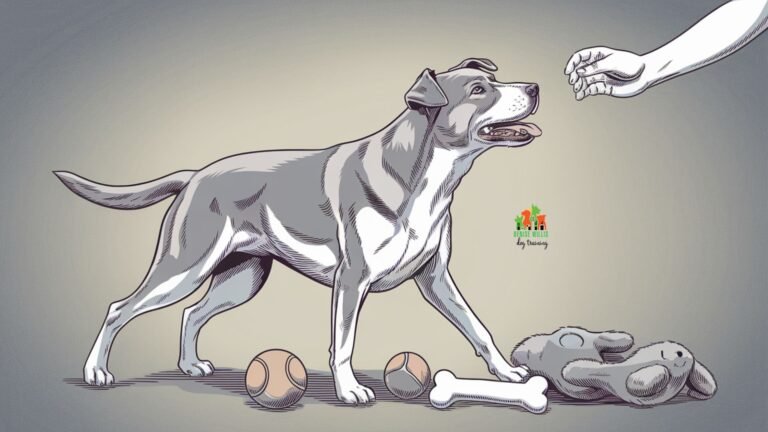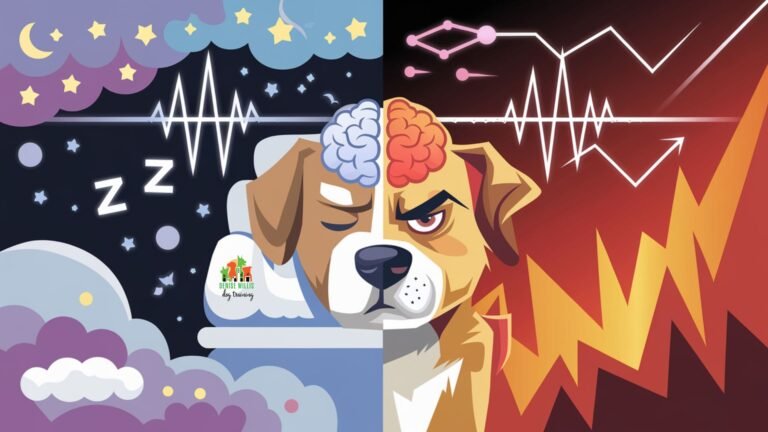📍 Service Area Notice: DW Dog Training provides in-person training services exclusively in the Greater Baltimore area. While our blog content is designed to help dog owners internationally, our hands-on training services are locally focused. For readers outside our service area, we hope you find value in our articles and welcome you to reach out with questions!
Ever wondered what your dog’s really saying? Dog body language is more complex than you think. Tail wagging doesn’t always mean happy, and a yawn isn’t just about being tired. Think you’ve got your furry friend all figured out? Think again. This isn’t your typical fluffy pet advice column. It’s a no-nonsense dive into the subtle (and not-so-subtle) ways your dog communicates. Buckle up – you’re about to discover a whole new language you’ve been missing all along.
Here are 15 body language signals your dog is constantly trying to tell you. Take any notes you want; this is free advice that, in my not-so-humble opinion, shouldn’t be free.

1. The Tail Wag: Not Always Happy
A wagging tail doesn’t always mean joy. Low and fast? Your dog’s probably afraid. High and stiff? That’s a sign of aggression or high arousal. Relaxed and swaying? Now we’re talking happiness. Tail wagging is complex, more like a mood ring than a simple on/off switch for “happy dog.”
2. The Ears: Your Dog’s Emotional Antennae
For dogs, ears are emotional billboards. Perked up and forward? Your dog’s alert and interested. Flattened against the head? Fear or submission is at play. Evolution pushed them toward this subtle language, it wasn’t their choice.
3. The Eyes: Windows to Your Dog’s Soul
A hard stare could indicate aggression. Whale eyes (when you can see the whites) signal fear or stress. Soft, blinking eyes show affection and trust. Understanding dog eye language comes from years of observation and learning.
4. The Mouth: More Than Just for Eating
A relaxed, slightly open mouth often indicates a happy, content dog. Tight lips, especially if you can see the teeth, can be a warning sign of aggression. Yawning isn’t always about tiredness – it can be a sign of stress or an attempt to calm a tense situation.
5. Body Posture: The Big Picture
A relaxed dog will have a neutral stance, weight evenly distributed. A fearful dog might lower their body, tucking their tail and making themselves small. An aggressive or assertive dog will often make themselves appear larger, with hackles raised and weight forward.
6. Lip Licking: Not Just About Food
Lip licking can be a sign of stress or discomfort. It’s often a calming signal, used to diffuse tension in a situation.

7. Raised Paw: The Canine Question Mark
When a dog raises a paw, it’s often a sign of indecision or mild anxiety. They’re literally and figuratively testing the waters, unsure about how to proceed in a situation.
8. Play Bow: Let the Games Begin
The play bow—front end down, rear end up—is an invitation to play and a sign that whatever follows (even if it looks a bit rough) is all in good fun.

9. Whale Eyes: A Sign of Discomfort
When you can see the whites of your dog’s eyes, it’s usually a sign that your dog is feeling stressed or uncomfortable. They’re trying to keep an eye on a perceived threat without turning their head.
10. Hackles Raised: Not Always Aggression
Raised hackles don’t always indicate aggression. They can also signal excitement or arousal. Context is key in interpreting this signal.
11. Shaking Off: Resetting the Emotional State
When a dog shakes off as if they’re wet (but they’re dry), it’s often a way of releasing tension or transitioning from one emotional state to another.
12. Freezing: The Calm Before the Storm
A dog that suddenly becomes very still, especially in a tense situation, may be preparing to react. This stillness can precede either flight or fight responses.
13. Sniffing: Sometimes a Calming Signal
While dogs obviously sniff to gather information, sometimes they’ll engage in intense sniffing as a way to calm themselves or diffuse a tense situation.
14. Yawning: Not Just Tired
Yawning isn’t always about being sleepy. In dogs, it can be a sign of stress or an attempt to calm a situation.
15. Rolling Over: Context is Key
A dog rolling over isn’t always asking for a belly rub. In some contexts, especially if the dog looks tense, it can be a sign of extreme submission or fear.

Common Misconceptions About Dog Posture
Now, let’s address some common misconceptions:
Misconception 1: A wagging tail always means a friendly dog
As we discussed earlier, tail wagging is complex. The position and speed of the wag can indicate various emotional states, not just happiness.
Misconception 2: A dog showing their belly always wants a belly rub
While some dogs do roll over for belly rubs, this posture can also indicate submission or fear, especially if the dog looks tense or is in an unfamiliar situation.
Misconception 3: Yawning only indicates tiredness
As we’ve seen, yawning in dogs can be a sign of stress or an attempt to calm a situation. Context is key in interpreting this behavior.
Misconception 4: Panting always means the dog is hot
While dogs do pant to cool down, excessive panting can also be a sign of stress or anxiety, particularly if the weather isn’t warm.
Understanding some breed-specific body language:
While all dogs use the same basic body language, some breeds may have unique tendencies. For example:
- Retrievers often carry their tails high and wag them quickly when excited, which can be misinterpreted as aggression in other breeds.
- Huskies and other Nordic breeds often have naturally upright ears, so subtle ear movements might be harder to detect.
- Breeds with naturally short tails, like Bulldogs, might not be able to express themselves through tail movements as clearly as long-tailed breeds.
Remember, though, that individual personality always trumps breed tendencies. Your dog is unique, and learning their specific body language is key to understanding them.
How to respond to different body language signals:
- When your dog shows fear or anxiety (lowered body, tail tucked, ears back):
- Give them space
- Avoid direct eye contact
- Speak in a soft, reassuring tone
- Don’t force interactions
- If your dog displays aggressive body language (stiff posture, hard stare, raised hackles):
- Stay calm
- Avoid direct eye contact
- Slowly create distance between your dog and the trigger
- Seek professional help if this is a recurring issue
- When your dog invites play (play bow, relaxed body, “smiling” expression):
- Respond positively if appropriate
- Ensure the environment is safe for play
- Be mindful of your dog’s energy level and know when to end play
Understanding and Preventing Dog Aggression:
Recognizing the signs of aggression early can prevent dangerous situations. Some signs include:
- Growling
- Snapping
- Showing teeth
- Hard staring
- Stiff body posture
It’s crucial to differentiate between aggression and play. Playful dogs will have relaxed body language, take breaks, and “self-handicap” (let the other dog or person win sometimes). Aggressive dogs will be intense, relentless, and escalate their behavior.
Aggression can stem from various causes, including fear, resource guarding, pain, or lack of socialization. Addressing the root cause is key to solving aggression issues.
Solutions for dog aggression often involve a combination of management (avoiding triggers), behavior modification (changing the dog’s emotional response to triggers), and sometimes medication in severe cases. Always consult with a professional trainer or behaviorist for aggression issues.
Some Further Reading:
Want to dive deeper into understanding your dog? Check out these related articles:
- Dog Aggression Vs. Playfulness: A Comprehensive Guide for Responsible Owners
- Dog Aggression Toward Children: Understanding the Root Causes and Effective Solutions
- Dog Aggression Solutions: A Complete Guide to Stopping Aggressive Behavior in Dogs
- Signs of Aggression in Dogs: How to Identify and Respond to Them for a Harmonious Home
These resources will help you further understand your dog’s behavior and how to address specific issues related to aggression and communication.
Essential Tools for Decoding Dog Body Language
Understanding your dog’s body language is crucial, but having the right tools can make the process easier and more enjoyable. Here are some resources that can help you on your journey to becoming fluent in “dog speak”:
- Dog Language: An Encyclopedia of Canine Behavior by Roger Abrantes This comprehensive guide offers detailed insights into canine communication, perfect for those wanting to dive deep into the subject.
- BARKIE Dog Training Kit A versatile kit including two clickers, a treat pouch, poop bags, and long training leash – essential tools for positive reinforcement training while working on body language cues.
- 360 Degree Furbo Dog Camera This smart camera allows you to observe your dog’s body language when you’re not at home, helping you understand their behavior in different situations.
- ThunderShirt Classic Dog Anxiety Jacket Useful for dogs showing stress signals, this comfort wrap can help calm anxious pets while you work on addressing their concerns.
- KONG Classic Dog Toy An excellent tool for observing your dog’s play behavior and body language during solo or interactive play sessions.
Remember, while these tools can be helpful, they’re no substitute for patience, observation, and professional guidance when needed.
Key Takeaways:
- Dog body language is complex and context-dependent.
- Tail wagging isn’t always friendly; consider the whole body.
- Stress signals include lip licking, yawning, and whale eyes.
- Breed can influence body language, but individual personality matters more.
- Respond calmly and appropriately to your dog’s signals.
- Early recognition of aggression signs is crucial for prevention.
- Professional help is important for addressing serious behavioral issues.
Frequently Asked Questions About Dog Postures
Can I learn to understand my dog’s body language perfectly?
While you can become very proficient, remember that dogs, like humans, are complex beings. There’s always more to learn!
My dog’s body language seems to contradict itself sometimes. Why?
Dogs, like humans, can experience conflicting emotions. This can result in mixed signals as they try to navigate complex feelings.
How long does it take to become fluent in dog body language?
It’s an ongoing process. You’ll pick up the basics quickly, but the nuances can take years to fully appreciate.
Is professional help necessary to understand my dog’s body language?
While many owners become quite adept on their own, a professional can offer valuable insights, especially if you’re dealing with behavioral issues.
Final Thoughts
Understanding your dog’s body language is like learning a new language – it takes time, patience, and practice. But the rewards are immeasurable. You’ll have a deeper connection with your furry friend, be better equipped to meet their needs, and create a happier, more harmonious household.
If you’re struggling to understand your dog’s body language or dealing with behavioral issues, don’t hesitate to seek professional help. At DW Dog Training, we’re passionate about strengthening the bond between dogs and their owners through better communication. Remember, every dog and every situation is unique. What works for one might not work for another. Contact us if you have problems decoding your dog’s postures or any other dog problems.
Are you ready to become fluent in your dog’s language? The journey starts with a single wag, a raised ear, or a playful bow. Your dog is always talking to you. It’s time to start listening.







